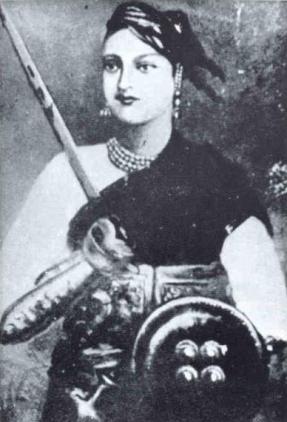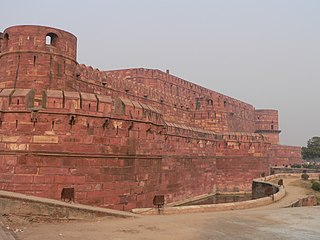
Lakshmibai Newalkar, the Rani of Jhansi, was the Maharani consort of the princely state of Jhansi in Maratha Empire from 1843 to 1853 by marriage to Maharaja Gangadhar Rao Newalkar. She was one of the leading figures in the Indian Rebellion of 1857, who became a national hero and symbol of resistance to the British rule in India for Indian nationalists.

The Indian Rebellion of 1857 was a major uprising in India in 1857–58 against the rule of the British East India Company, which functioned as a sovereign power on behalf of the British Crown. The rebellion began on 10 May 1857 in the form of a mutiny of sepoys of the company's army in the garrison town of Meerut, 40 mi (64 km) northeast of Delhi. It then erupted into other mutinies and civilian rebellions chiefly in the upper Gangetic plain and central India, though incidents of revolt also occurred farther north and east. The rebellion posed a military threat to British power in that region, and was contained only with the rebels' defeat in Gwalior on 20 June 1858. On 1 November 1858, the British granted amnesty to all rebels not involved in murder, though they did not declare the hostilities to have formally ended until 8 July 1859.

Field Marshal Hugh Henry Rose, 1st Baron Strathnairn, was a senior British Army officer. He served as a military adviser to the Ottoman Army who were seeking to secure the expulsion of the forces of Mehemet Ali from Syria during the Egyptian–Ottoman War. He then fought with the French Army at the Battle of Alma, the Battle of Inkerman and at the Battle of Mamelon during the Crimean War. During the Indian Rebellion of 1857 Rose was given command of the Central Indian Field Force and was successful at the battle of Jhansi in April 1858, at Lahar in May 1858 and at Gwalior in June 1858. He went on to be Commander of the Bombay Army, Commander-in-Chief, India and then Commander-in-Chief, Ireland.
Mandla is a city with municipality in Mandla district in the Indian state of Madhya Pradesh. It is the administrative headquarters of Mandla District. The city is situated in a loop of the Narmada River, which surrounds it on three sides, and for 15 miles between Mandla and Ramnagar, Madhya Pradesh the river flows in a deep bed unbroken by rocks. The Narmada is worshiped here, and many ghats have been constructed on the banks of the river. It was a capital of the Gondwana Kingdom who built a palace and a fort, which in the absence of proper care have gone to ruins.

The Bundelkhand Agency was a political agency of the British Raj, managing the relations of the British government with the protected princely states of the Bundelkhand region.

Maharaja Gulab Singh Jamwal (1792–1857) was the founder of Dogra dynasty and the first Maharaja of the princely state of Jammu and Kashmir, which was a part of Panjab and Sikh Empire became the largest princely state under the British Raj, which was created after the defeat of the Sikh Empire in the First Anglo-Sikh War. During the war, Gulab Singh sided with British to protect himself and his family after the death of Maharaja Ranjit Singh. and He was the Prime Minister of Sikh Empire. The Treaty of Amritsar (1846) formalised the transfer of all the lands in Kashmir that were ceded to them by the Sikhs by the Treaty of Lahore.
Garhakota is a town and a municipality in Sagar district in the state of Madhya Pradesh, India. It's also a tehsil headquarter

Raja Nahar Singh was the Raja of the princely state of Ballabhgarh in Faridabad District of Haryana, India. He fought against The East India Company in the Indian Rebellion of 1857. The small kingdom of Ballabhgarh is only 20 miles from Delhi. Nahar Singh Stadium in Faridabad is named after him. The Raja Nahar Singh metro station in Violet line is also named after him.
Shahgarh is a town and a tahsil in Sagar district in the Indian state of Madhya Pradesh. Its connected with National Highway No. 86 Route, National Highway 539 and MP SH 37.

Chanderi Fort located at Chanderi in Ashoknagar District of Madhya Pradesh state in India is situated at a distance of 127 km from Shivpuri and 37 km from Lalitpur and about 45 km from Esagarh and 38 km from Mungoali It is located on a hill southwest of the Betwa River. Chanderi is surrounded by hills, lakes and forests and there are several monuments. Chanderi finds mention in Mahabharata. Shishupal was the king of Mahabharata period.

The Battle of Agra was a comparatively minor but nevertheless decisive action at the end of a prolonged siege during the Indian Rebellion of 1857.
The 3rd Bombay European Regiment was an infantry regiment raised by the British East India Company in 1853. They were created originally for the defence of Bombay (Mumbai) and were stationed initially in Pune, but they were soon called upon to quell the Indian Rebellion of 1857.

Jhansi Fort or Jhansi ka Qila is a fortress situated on a large hilltop called Bangira, in Uttar Pradesh. It served as a stronghold of the Chandela Kings in Balwant Nagar from the 11th through the 17th century.

Raja Venkatappa Nayaka IV or Nalvadi lakshya (?–1858), was a prominent final ruler from the Nayak Dynasty of Shorapur in present-day Yadgiri district of Karnataka state. He refused to accept the suzerainty of the British East India Company and waged a war against them during the Indian Rebellion of 1857. He also aligned the southern kings to fight against the British and created an alliance consisting of Jattu, Jamkhandi State, Mudhol State, Naragund and Koppal states.

Jhansi was an independent princely state ruled by the Maratha Newalkar dynasty under suzerainty of British India from 1804 till 1853, when the British authorities took over the state under the terms of the Doctrine of Lapse, and renamed it the Jhansi State. Before the takeover, it was under the Peshwas from 1728 to 1804. The fortified town of Jhansi served as its capital.

Pateriya Ji, is a jain temple site in Madhya Pradesh, India, on the outskirts of Garhakota in Sagar district. This is an atishaya kshetra
The Garha Kingdom, also called Garha Mandla or Garha Katanga, was an early-modern-era kingdom in India. It was the first large kingdom to be founded by the Gond tribe and dominated much of Central India at its peak.

Tantia Tope was a notable commander in the Indian Rebellion of 1857.
Rana Beni Madho or Beni Madho Baksh Singh Bais was one of the most important leaders in the Indian rebellion of 1857 from the Oudh region. He belonged to the Bais clan of Rajputs and was the ruler of the Shankarpur estate in modern-day Rae Bareli, part of the old Baiswara region in Oudh. He led a rebellion against the British forces in 1857. His son was married to the grand daughter of another prominent revolutionary leader Kunwar Singh of Jagdishpur estate.

Shahgarh is a village and community development block headquarters in Gauriganj tehsil of Amethi district, Uttar Pradesh, India. As of 2011, it has a population of 3,201 people, in 525 households. It historically was the seat of a taluqdari estate held by a branch of the Bandhalgoti Rajputs. Today it serves as the seat of a nyaya panchayat which also includes 13 other villages.














